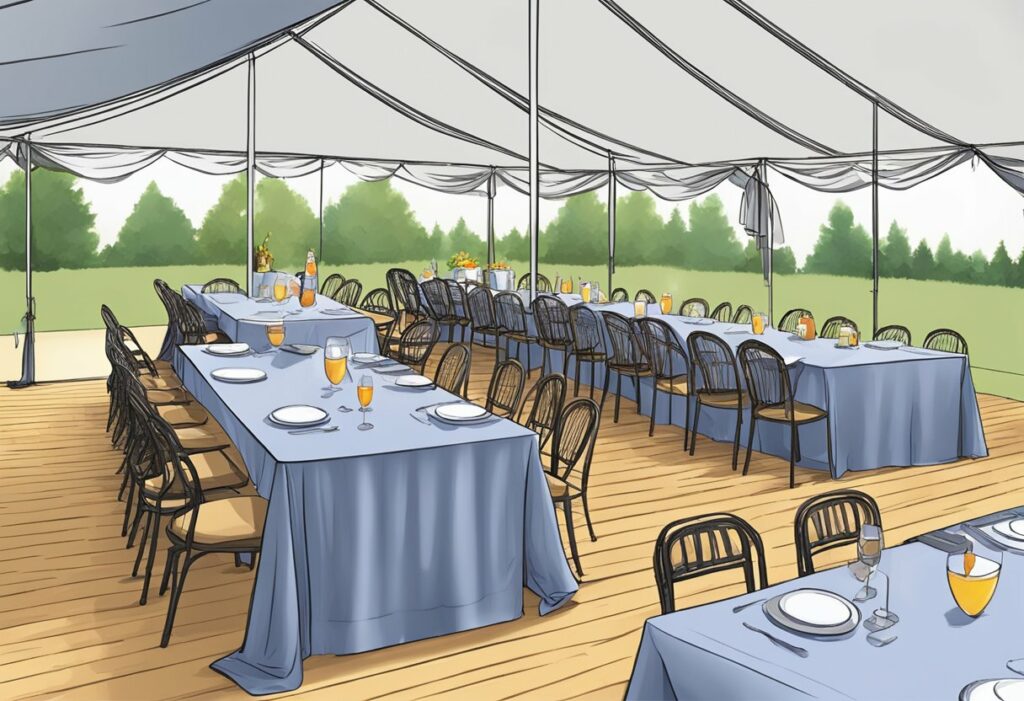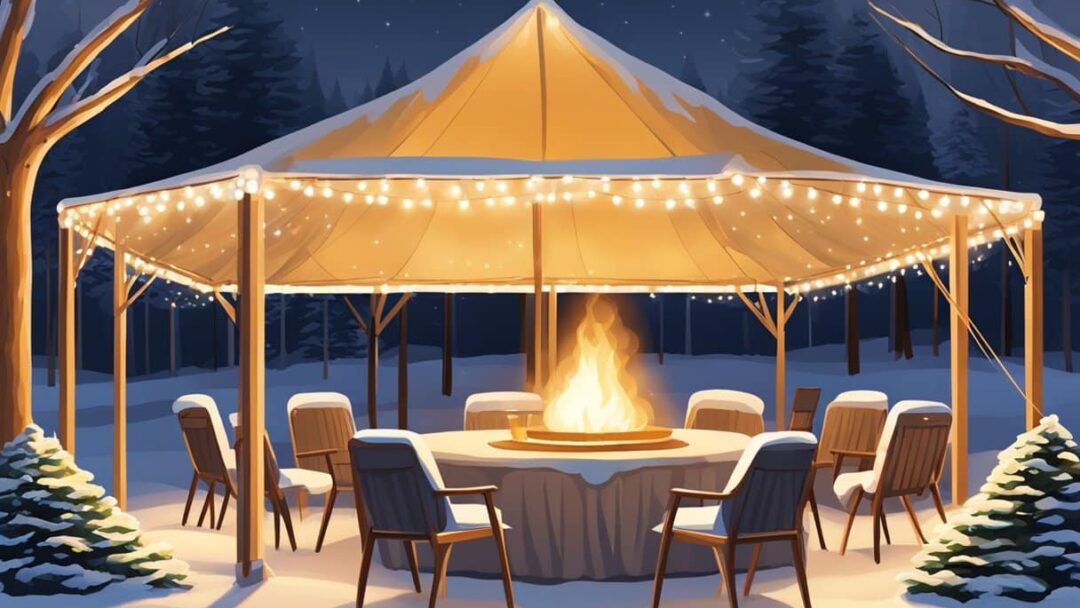Hosting an event outdoors can present a unique set of challenges, especially when it comes to maintaining a comfortable temperature within a party tent. As temperatures drop during the fall and winter months, ensuring that your guests remain warm becomes a priority. A well-heated tent can be the difference between a cozy, memorable event and an uncomfortable experience for everyone involved.
Strategizing the heating of a party tent involves more than just cranking up a heater; it requires careful consideration of the type of heaters suitable for tents, the proper placement for optimal warmth, and the necessary safety precautions to prevent accidents. Insulating the tent with sidewalls and ensuring proper ventilation are also crucial to keep the warmth in and the cold out. By understanding the basics of how to effectively heat your party tent, you can host a successful event regardless of the chilly weather outside.
Key Takeaways
- Effective tent heating is essential for guest comfort during cold-weather events.
- Safety and proper heater placement are key to successful tent heating.
- Insulation and ventilation play crucial roles in maintaining consistent warmth.
Understanding Tent Heating Basics
When planning an outdoor winter party tent, the comfort of guests is paramount. Heating a party tent effectively requires understanding the types of tents, choosing the right tent heater, and considering weather conditions.
Types of Party Tents
There are two primary types of party tents: pole tents and frame tents. Pole tents rely on central poles and stakes spread out over the area to maintain their structure, which can limit heater placement options due to central obstructions. Frame tents, on the other hand, have a metal framework that supports the tent from the outside, providing unobstructed space within and more flexibility in heater placement.
Selecting the Right Tent Heater
Selecting the correct tent heater is crucial for maintaining a comfortable temperature. The key to choosing an effective heater involves considering the tent size and heat output, typically measured in BTUs (British Thermal Units). It’s essential to use heaters that are specifically designed for tent use to ensure safety. Tent heaters come in various types, including electric models for smaller tents and propane or diesel models for larger spaces. Heaters should be placed strategically to maximize efficiency and maintain consistent warm air distribution.
Weather Factors Impacting Tent Heating
The efficiency of tent heaters can be significantly affected by weather conditions. Extreme cold temperatures, wind, and humidity can increase the amount of heating required to keep a party tent warm. It is important to use tent sidewalls to protect against wind and retain heat. Vents or openings may be necessary to ensure proper ventilation, especially when using gas heaters, to prevent the buildup of dangerous fumes. During setup, ensure the tent orientation minimizes exposure to prevailing winds for optimal insulation and heating performance.

Preparation and Safety Measures
When heating a party tent during cooler months, it’s imperative to prioritize safety and proper setup. This not only ensures a comfortable environment but prevents potential hazards.
Securing the Tent Structure
To ensure safety, the tent structure must be sturdy and well-anchored. Sidewalls play a significant role in retaining heat and should be securely fastened to avoid gaps where warm air can escape. Regularly check that all supports and anchor systems are tightly in place to maintain stability even in windy conditions.
Assessing Ventilation Requirements
Proper ventilation is crucial to prevent the buildup of harmful gases, particularly if using fuel-burning heaters like those powered by propane. There should be a balance between maintaining a warm temperature and allowing a consistent flow of fresh air. Positioning tent sidewalls to help direct airflow and incorporating structured vent areas allows for both warmth and safety.
Fuel and Heater Safety
When using heaters fueled by propane or other fuel sources, safety measures are essential. Store propane tanks and fuel containers away from heat sources and ensure they are in a well-ventilated area to prevent fume accumulation. Always follow the manufacturer’s guidelines for heater operation and place them on a non-flammable surface. It’s also critical to have a safety plan that includes fire extinguishers and clear access to exits.
Remember, safety overrides convenience, and thorough preparation is the key to a successful and warm event under the tent.
Optimal Heating Strategies
In ensuring a cozy environment within a party tent during colder months, the strategic placement of heaters and the effective use of sidewalls and tarps are crucial.
Placing Heaters for Maximum Efficiency
It’s important to place tent heaters in a way that distributes warmth evenly throughout the space. For example, if one is using a commercial-grade heater, it should be positioned at the center of the tent or at several points along the perimeter depending on the tent size. Diffusers can be attached to the heaters to guide the warm air flow, preventing it from rising immediately to the top of the tent, thereby increasing efficiency.
Utilizing Tent Sidewalls and Tarps
Tent sidewalls and tarps play a pivotal role in retaining heat within a party tent. By attaching sidewalls to the tent, one traps the warm air inside, reducing heat loss due to wind and other elements. Additionally, using tarps as additional insulation on the flooring can further prevent cold from seeping up from the ground, ensuring that guests are comfortable even in lower temperatures.
Enhancements and Accessories for Heat Retention
Effective heat retention within a party tent hinges on proper enhancements and considered accessories. Strategic use of flooring and purpose-selected lighting can maintain conducive temperatures for any event.
Improving Heat Distribution With Flooring
Insulated flooring serves a dual function: it offers a stable surface underfoot and significantly reduces heat loss to the ground, especially during cold seasons. High-quality thermal mats or carpeting can act as barriers against the cold earth. For optimal effect, combining these with a layer of styrofoam insulation beneath the flooring material is advised.
Lighting and Accessories That Influence Temperature
When it comes to heating, not all tent lighting fixtures contribute equally. Infrared heat lamps provide both illumination and warmth, directly radiating heat to guests and objects below. On the contrary, LED lights are cooler and won’t add much to ambient temperatures but are energy efficient for long events. Other accessories like thermal curtains or insulated sidewalls can be deployed to prevent warm air from escaping, while reflectors can optimize heater placement by directing heat where it is most needed.
Seasonal and Event Considerations
When planning an event in a party tent, it’s crucial to tailor heating solutions to the season and the specific type of gathering to ensure guest comfort and safety.
Heating Solutions for Winter Events
Winter weddings and other winter events pose a particular challenge due to colder temperatures. Heating an outdoor party tent effectively requires a robust system. The use of energy-efficient outdoor heaters or propane heaters is recommended to create a warm and inviting environment inside the tent. It’s also essential to include tent sidewalls to contain the heat and prevent it from escaping. For a fall wedding, heaters might need to be supplemented with floor coverings and insulated drapes to maintain a comfortable temperature. These additions are particularly vital as evenings become chillier in the late autumn months.
Adapting Heating Approaches for Summer Gatherings
In contrast, summer gatherings in an outdoor party tent may only require minimal heating solutions as the days are typically warmer. However, evenings can still be cool, and a light heating source might be necessary. Portable electric heaters can offer sufficient warmth without overwhelming guests. In the context of weddings or other formal summer events, aesthetic considerations like decorative firepits can provide both heat and ambiance. For all summer events, the heating approach should adapt to the drop in temperature from day to night, likely making use of temperature controls for the best guest experience.
Practical Aspects of Tent Heating
When planning a party in a tent during colder months, understanding the heating requirements and preparing for varying weather conditions is crucial for comfort and safety.
Understanding Tent Heater Capacity
To ensure the ideal temperature within a party tent, one must select a tent heater with adequate capacity. A heater’s capacity is generally measured in BTUs (British Thermal Units). Here’s a simple process:
- Measure the tent’s volume in cubic feet (length x width x height).
- Calculate the desired temperature increase in Fahrenheit.
- Multiply the volume by 4 BTUs to achieve a rough estimate of the required heater capacity.
For instance, a 20×30 foot tent with a 10-foot ceiling requires a heater with a minimum output of:
- Volume = 20 x 30 x 10 = 6000 cubic feet
- For a 30°F increase: 6000 x 4 x 30 = 720,000 BTUs
Given freezing temperatures, a higher capacity heater may be needed.
Dealing With Extreme Weather Conditions
Prior to the event, checking the weather forecast is important to anticipate the need for additional heating solutions. In cases of extreme cold, multiple heaters strategically placed can help maintain a consistent temperature throughout the tent. Here are important tips:
- Insulation: Use insulated tent sidewalls to retain heat.
- Placement: Position heaters to distribute warmth evenly, ensuring none are directly facing areas where guests will be seated or standing to avoid discomfort.
- Safety: Always follow manufacturer guidelines for clearance and ventilation to prevent any hazards.
Weatherproofing measures like adding sidewalls should also be considered if weather conditions include wind or precipitation.
Tent Heating Logistics and Services
Proper tent heating during winter events ensures comfort and safety. This aspect of party planning requires attention to detail in terms of equipment rental, delivery, and setup to maintain a warm and inviting atmosphere inside the party tent.
Arranging Heater Rentals and Deliveries
When planning a winter tent event, one must arrange for heater rentals well in advance. Choose a reliable tent rental service that offers a variety of heaters suitable for the tent size and number of guests. Ensure that the service includes delivery and pickup of the heaters to the event location. Confirm the type of fuel required, be it electricity or propane, and if needed, schedule a generator rental for a seamless power supply.
- Checklist for Heater Rentals:
- Confirm availability and book in advance
- Select appropriate heater size and type
- Schedule delivery and pickup times
- Arrange for a generator if necessary
Setting Up and Testing The Heating System
Once the heating system arrives, the setup process should be carried out by professionals. It’s crucial that the heaters are positioned to distribute warm air evenly throughout the party tent while ensuring safety by keeping them away from flammable materials. After installation, perform a thorough test to ensure everything is operational and adjust the settings to the desired comfort level. It’s essential to maintain steady tent heating without overheating or underheating the space.
- Steps for Heating System Setup:
- Professional installation of heaters
- Position heaters for even distribution
- Test the system prior to the event
- Adjust settings for optimal comfort
Remember, for tent heating services and logistics, meticulous planning paired with professional execution is key to a successful and warm event experience.

Long-Term Considerations and Maintenance
Proactive maintenance and preparation are crucial for ensuring the longevity and reliability of party tents and heaters. These measures protect one’s investment and ensure readiness for future events.
Preserving Tent and Heater Quality
Heater Maintenance: To prevent malfunctions and enhance durability, heaters must be checked and serviced regularly. For equipment made of materials prone to rust, such as metal components, they should be kept dry and possibly treated with rust-resistant products.
Tent Care: Party tents, particularly those from Tent and Table, are robust, but still require careful handling and storage. They should be cleaned regularly, and any minor damages should be repaired promptly to avoid further deterioration. If the tent is being used in winter, one must ensure to winterize the tent by investing in heavy-duty materials that can withstand snow and colder temperatures.
Preparing for Future Events
Equipment Storage: All equipment, including water barrels, should be stored in a cool, dry place away from direct sunlight to prevent damage from UV exposure.
Inventory Management: After each event, taking inventory of all the pieces ensures nothing is lost or needs replacing. Utilizing off-season sales to replace or supplement existing items can be cost-effective and ensures one’s equipment remains cutting-edge and reliable.
This meticulous attention to detail in maintenance and future planning ensures the readiness and quality of party tent equipment for any upcoming event.
Additional Event Essentials
In planning an event, one must consider not only the temperature control within party tents but also the practical aspects that contribute to the comfort and functionality of the space. The two critical areas of focus should be providing appropriate furnishings and securing a reliable power supply.
Furnishing The Party Tent
Furnishing the interior of a party tent goes beyond aesthetics; it involves selecting pieces that are sturdy and stable to ensure guest comfort and safety. When choosing tables and chairs, one must prioritize durability and stability to withstand the outdoor elements and potential movement within the tent. Whether the event calls for banqueting tables, round seating arrangements, or cocktail tables for light refreshments, the furniture must complement the overall layout and size of the tent.
- Tables: Ensure they are weighted and won’t tip over.
- Chairs: Opt for heavy-duty versions that won’t easily blow over or collapse.
Ensuring Steady Power Supply
A steady power supply is vital for myriad functions within a party tent, from lighting to entertainment. Reliance on a generator may be necessary, especially for locations lacking direct access to electricity. When selecting a generator, it’s crucial to choose a unit that can handle the total load of all electrical needs without risk of failure. Moreover, the generator should be placed at a safe distance from the tent to minimize noise and ensure the safety of all attendees.
- Generator: Pick a model that provides enough wattage for your needs, yet operates quietly and efficiently. Ensure it’s well-ventilated and positioned away from flammable materials.
Frequently Asked Questions
These questions address common concerns and considerations for maintaining warmth in an outdoor party tent.
What is the best way to heat an outdoor party tent?
The best heating solution often involves energy-efficient outdoor heaters, ideally designed specifically for outdoor use, to maintain a comfortable temperature inside the tent.
Are propane heaters safe to use inside a party tent?
Propane heaters, when used with proper ventilation and safety measures, can be safe for heating a party tent. It’s important to follow the manufacturer’s instructions and local regulations closely.
How many BTUs are needed to adequately heat a large party tent?
The required BTUs depend on the size of the tent and the outdoor temperature. A general rule is to provide approximately 3 to 5 BTUs per cubic foot of space in the tent.
What is the ideal number of heaters required for an outdoor wedding tent?
The number of heaters depends on the tent’s size and layout. For large tents, it’s often recommended to have more than one heater distributed strategically to ensure even heating throughout the space.
How can you keep a party tent warm during winter events?
To keep a tent warm in winter, one should use insulated tent sidewalls to trap heat and consider using ground covers or carpets to minimize cold from the ground.
What are the alternatives to electric heaters for warming up a party tent?
Alternatives to electric heaters include propane and gas heaters, radiant heat sources, and for a more rustic approach, heated water bottles placed strategically around the tent can provide makeshift warmth.

